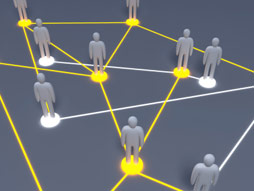|
|

By Ed Finegold
Communications media, be they Internet-born or from the CSP world, enable and create communities. Websites like Facebook and LinkedIn reveal this effect in the online social media behavior they encourage. There’s a river of human behavior information that flows through communications and media providers. Some of it is collected in small buckets, and some of that is analyzed. However, most of what’s out there is still… out there: A frontier to explore where sociology, group psychology, and the viral effect interact. Under the covers of CSPs’ customer and usage data is a world of knowledge about the social networking forces that impact its own customers, services, offers, devices, and brands. If CSPs want to know how to monetize the online phenomena they see, a glimpse into this world is eye opening.
The Idiro Effect
The folks at Idiro like to talk about friends, influences, desire, promiscuity, “virality,” contagion, and death. It makes for stimulating conversation. Aidan Connolly, CEO and Simon Rees, executive vice president of sales and marketing, say that social networks and communities exist in the ether of CSP’s usage and billing data. They can be uncovered quickly and used to drive marketing, engage customer groups, and combat churn.
|
|
CSPs want to know how to monetize the online phenomena they see. |
|


social communities and predict how factors like normative pressure, individual influence, and product reputation will drive customer behavior. “We can figure the way influence will travel,” Rees says. He says it is possible to map how individuals drive or dissuade uptake of their services across groups or communities. “Some services are contagious,” Rees says. “If one person takes it up in a group, then the chance is much higher the others will want it.” Similarly, it’s possible to “plot the virality” of anything from device uptake to churn. Rees says, “We observe everywhere that churn is contagious.”
|
|
|
|

“All of the choices we make are to some extent influenced by others in our community,” Rees said, matter-of-factly. He argues that because we have so many commercial decisions to make, and tend to be more cynical in today’s media society, we rely on friends more. “The influence of people on their friends is an important mediator for marketing,” Rees says. “You can watch a joke, an idea, or a new restaurant spread through a community. You can see how much normative pressure there is in groups,” he says.
Idiro’s solution is a SaaS offering that analyzes customer, usage and billing data to identify
|
|

In this complex world of clairvoyance by analysis, people tend to fall into three major categories (with exceptions, of course). There are some, Rees says, who are “quite parochial” and communicate entirely within one community. They can be important decision makers in that community even if they don’t appear to have much communication outside of it.
“Others,” he says, “are promiscuous and have multiple interests.” These people tend to play different roles in different communities from leader to follower. Third, he says, are people who are neither promiscuous nor parochial.
article page
| 1 | 2 | 3 | |
|
|






